The five boroughs of New York City still contain some surprisingly raw terrain, and Antonio Rovaldi created the humbly monumental art project of charting their coastlines. While a focus on coastal lands in a time of sea level rise cannot avoid engaging issues of climate change, Rovaldi’s offhanded, reflective approach obliquely makes way for surprising possibilities.
Texte disponible uniquement en anglais
Just as the Earth is in constant rotation, Milan-based artist Antonio Rovaldi is a man in perpetual motion. Yet as he goes—on the road and around the world—he stays in contact with the earth through his artwork. Often using photography, but also video, writing, installation, and other media, his artworks chart the visceral relationships he develops with specific landscapes. His current endeavor, a multi-year investigation of the coastlines of the five boroughs of New York City, goes by different names in its different manifestations. Starting this past year, exhibitions and other events have been happening in various locations in the United States and in Europe. All of this project activity, under the umbrella title End. Words from the Margins: New York City, has been made possible by an artist’s grant from the Italian Council, whose Ministry of Cultural Heritage and Activities and Tourism (MiBACT) awarded Rovaldi its fifth annual national prize in February 2019.
As threats to the land’s health have become increasingly palpable, it is perhaps inevitable that Rovaldi’s work would begin to reflect this concern. But when Rovaldi decided to turn his camera lens on New York City, he did not expect to be making a project about climate change. He was simply enchanted with the metropolis, and wanted to find his own way of seeing the most densely developed and hyper-mythologized real estate on the planet. For two years, starting in Spring 2016, Rovaldi traveled on foot and by bicycle to all five boroughs of the city, photographing constantly. He also undertook extensive research. He learned about the land’s history through books, maps, ephemera, and other media, including the early silent art film Manhatta by Paul Strand and Charles Sheeler, which is structured using excerpts from Walt Whitman’s poetry (the excerpts from Whitman in this essay are different from those quoted in the film). This influential film foregrounds the magnificence of the city, and the myriad movements of its inhabitants, and many shots of the city’s industrial buildings include visually poetic yet ecologically disturbing views of steam—or smoke?—curling into the air.
Perhaps any examination of New York City must contend with the natural environment.
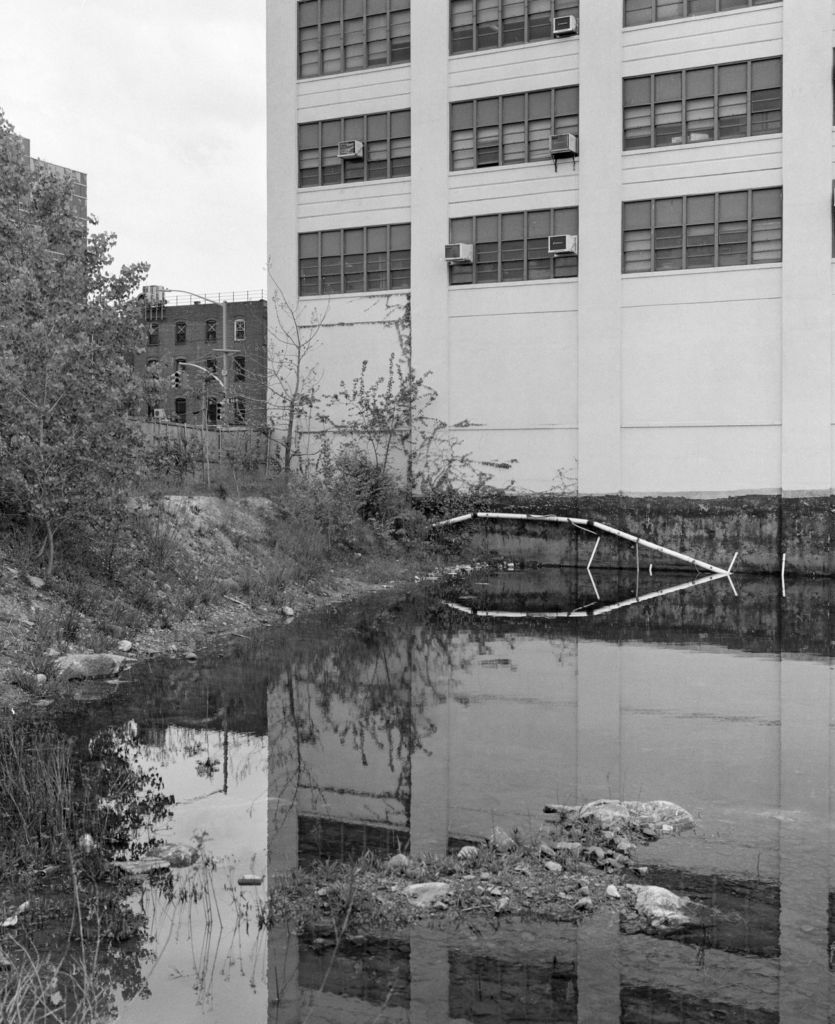
May 11, 2017 / Commercial St and Box St © Antonio Rovaldi
Land Lover
Rich, hemm’d thick all around with sailships and steamships, an island sixteen miles
— Walt Whitman, Mannahatta
long, solid-founded,
Numberless crowded streets, high growths of iron, slender, strong light, splendidly
uprising toward clear skies,
Tides swift and ample, well-loved by me…
Rovaldi’s love for New York, and his fascination with its landscape, stretches back to when he started spending time in the city in 2005. And he unconsciously started working toward his five-borough project in 2009, when he had an artist’s residency at the International Studio & Curatorial Program (ISCP) in Brooklyn. One day, he walked with Michael Höpfner, a fellow artist from the program, along the entire length of Broadway in Manhattan. Höpfner was blindfolded and Rovaldi’s ears were blocked, so both men experienced intensified perceptions of the landscape through their other senses. While another artist friend documented the adventure on video, they passed from the island’s southern skyscrapers through the theater district and commercial zones to the raw, northernmost parkland in Inwood still associated with the Native village name, Shorakkopoch. Rovaldi reflected on the experience in Shorakkapoch—a collaborative installation (2009) and chapbook (2010).
At the end of that tiring marathon, as the friends rested in Inwood Hill Park, they were surprised to hear the hollow tock-tock-tock of a woodpecker. Such a primordial sound, after a day absorbing the world’s most urban artery. The experience lodged in Rovaldi’s imagination, and it provided him with a title: Rovaldi’s current project is documented in a thick compendium of photographs and texts called The Sound of the Woodpecker Bill: New York City (2019). “The Sound of the Woodpecker Bill” is also the name of the most recent and most elaborate exhibition associated with the book, which opened February 13, 2020 at Galleria d’Arte Moderna e Contemporanea (GAMeC) in Bergamo, Italy.
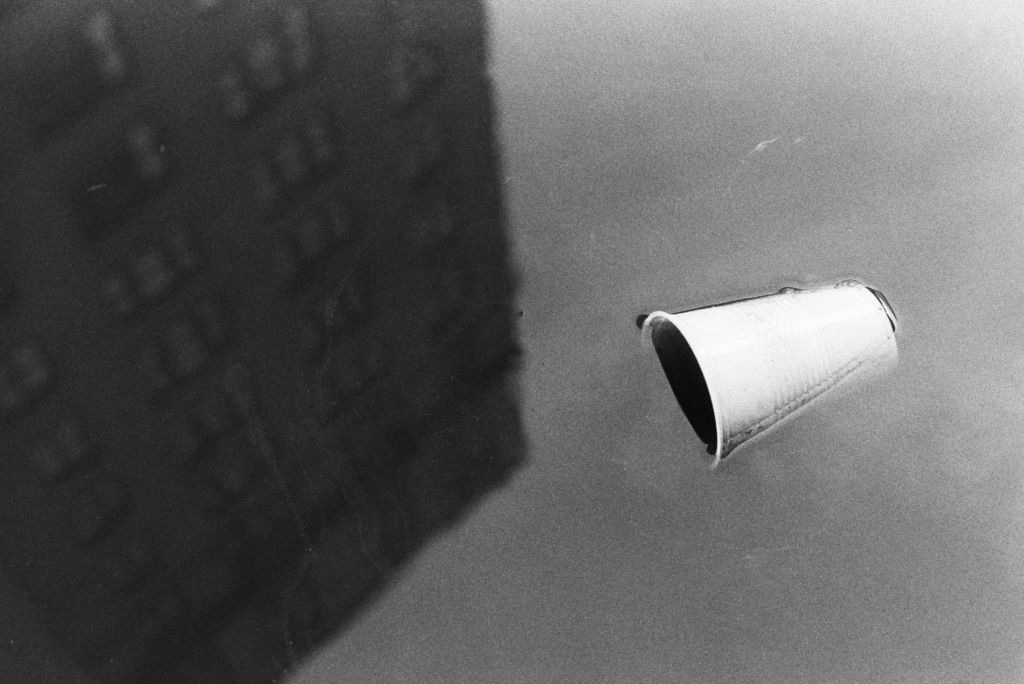
From the “PROLOGUE” series © Antonio Rovaldi
I too had receiv’d identity by my body,
That I was I knew was of my body, and what I should be I knew I should be of my body.— Walt Whitman, Crossing Brooklyn Ferry.
Rovaldi’s approach grows out of his other photographic books surveying other landscapes. Most significantly, in the years leading up to the New York City project, Rovaldi completed a similarly motivated photographic study of his native Italy, which became the book Orizzonte in Italia (2015). For this work, he bicycled along the coastlines of the Italian peninsula and the island of Sardinia, photographing the sun and sky, with his camera facing outward from the shore. Each photograph contained a horizon line, but Rovaldi realized that the thread connecting the images was not exactly the land or sea, or even the rising or setting sun which appeared in many of his images. Sol LeWitt had already explored that theme, anyway, in his artist’s book Sunrise and Sunset at Praiano (1980). Rovaldi saw that his own photographs, instead, were growing out of his bodily relationship to the land: the fact of his bicycling; the choice to fasten his gaze on a point perpendicular to the shoreline. His physical exhaustion chronicled the terrain’s immensity, and his exhaustion of the seascape perspective challenged his ability to perceive its variety in ever fresh ways.
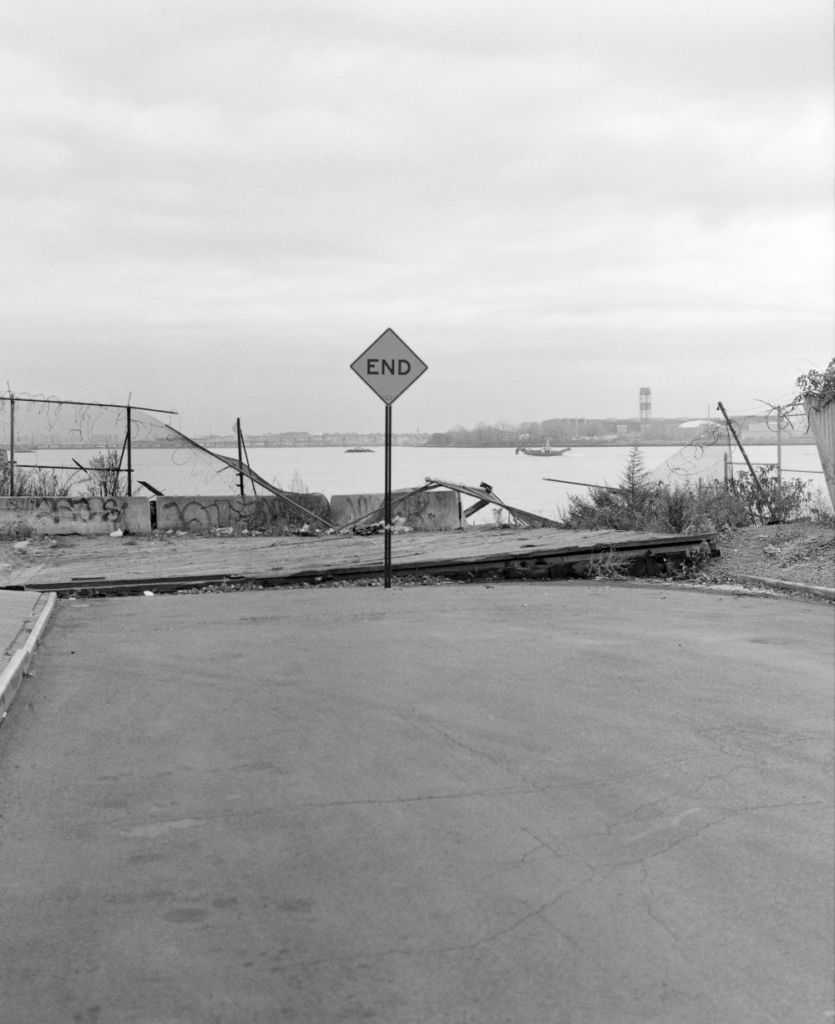
November 14, 2017 / Cedar Ave © Antonio Rovaldi
The primary tone of this project emerged not as exhaustion, but as love. Bicycle travel puts the rider into intimate contact with the land’s contours and atmospheres; framing its vistas prods the photographer—and us viewers—into appreciating its beauty. Rovaldi began to regard his artistic exploration of the land as a relationship with a lover: a connection that is both physical and beyond physical. The more he got to know the land, the more he realized there was to know. And, like in so many intimate relationships, if he treated the land with respect, it would offer itself back to him.
New Views
After Rovaldi had finished exploring Italy’s coastlines, he returned to New York and began to explore its landscape using a similar methodology. Biking, walking—always moving— relating to the land through physical exertion. But he found that his coastal access was often blocked. Barbed wire and fences were punctuated by signs reading, with deadpan plainness, “End.”
How could he establish a relationship with a landscape that he could not traverse? Even when he was able to set foot on the shore, his view toward the horizon was often cluttered with buildings and other structures that were rising into the sky, across the water from where he stood. And when he walked around the city’s central and most built-up borough, Manhattan, he realized that his sight lines seldom extended very far at all. The city seemed stubborn, as hard as the schist that serves as its natural stone foundation. Its obstacles demanded a new approach.
The solution came through obedience, not exactly invention: New York’s landscape forced Rovaldi to aim his camera at close range while he pivoted amidst the buildings and other obstacles. The sight lines often stayed limited to the tight radius directly around his body. This significant shift is not just about changing from a panorama to a close-up: it also reveals the relational dynamics between the artist and the landscape. Instead of devising and imposing a fixed visual strategy upon New York’s territories, based on his previous experience, Rovaldi adopted a stance of improvisational responsiveness. The city presented itself in shades of gray, for instance, so the book is printed entirely in black and white. And as he let this fresh way of photographing emerge, Rovaldi began to see scenes he would not have noticed otherwise. He crafted stark, stunning images of intrepid weeds, vernacular architecture, evocative items that were cast away. A purely visual “prologue” of photographs exposes Manhattan’s interior. Years of photographs of the five boroughs’ coastal territories were edited in 2018 into the hundreds of images that form the five chapters of the book; some images from each chapter are shown in the exhibitions. Very few shots include people: The landscape is the main character. Respecting and loving the land has led again to a revelation of its unique qualities.
Rovaldi sees the practice of responsiveness as a metaphor for a way of dealing with climate change. Who knows what the future may bring, if we follow the land’s lead? He has already demonstrated the effectiveness of this approach: by following his visual instincts, he uncovered insights not only into the details of a specific landscape, but also into the dynamics of how a person can relate to a landscape.
Responding Collaboratively
Each singing what belongs to him or her and to none else, […]
Singing with open mouths their strong melodious songs.— Walt Whitman, I Hear America Singing.
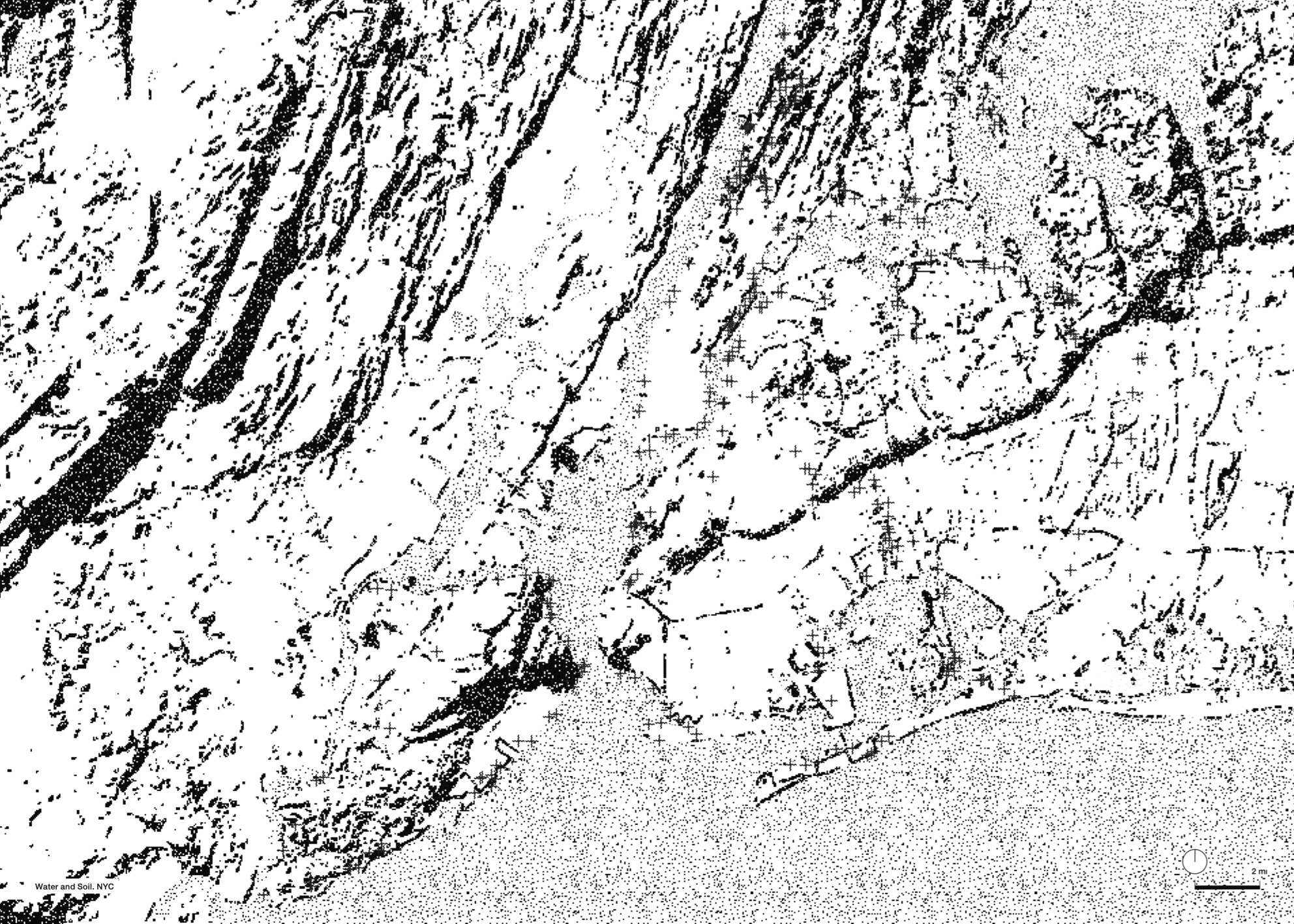
Water and Soil, NYC, by Francesca Benedetto
Rovaldi’s responsive approach goes beyond simply tuning into the land. A primary aspect of it is that he recognizes the limitations of his own perspectives, so he orchestrates collaborations. After all, a variety of insights leads to a more complicated, engaging, and non-egocentric view of the New York City landscape. And the process of collaboration, itself, could model a response to climate change, which certainly requires globally collective efforts. As the project ripened, and Rovaldi prepared to apply for the grant from the national Italian Council, he built a coalition of institutions, coordinated by Lorenzo Giusti, a curator at GAMeC, the project’s primary sponsoring institution. The structure of the grant itself communicates a collaborative working method: the Italian Council’s Ministry of Cultural Heritage and Activities and Tourism (MiBACT) works with the Directorate General for Contemporary Art and Architecture, as well as with a division called Urban Peripheries (a fitting title for Rovaldi’s endeavor). The goal is to fund projects that bring the works of contemporary Italian artists into global view. Events were planned, accordingly, at institutions on both sides of the Atlantic. An initial exhibition has already taken place at Harvard University: Rovaldi partnered with his friend Francesca Benedetto, a design critic in landscape architecture at Harvard’s Graduate School of Design, to create End. Words from the Margins: New York City at the school’s Frances Loeb Library. The curatorial team for this exhibition (as well as for the major exhibition at GAMeC) consists of Giusti, Benedetto, and restoration ecologist Steven Handel. Book release events have been planned for the Magazzino Italian Art in Cold Spring, New York, and the Kunstmuseum St. Gallen, in Switzerland; another discussion has already taken place at New York University’s Casa Italiana Zerilli-Marimò in Manhattan.
The book that is the most enduring record of Rovaldi’s vision, The Sound of the Woodpecker Bill: New York City, is an emblem of his collaborative method. To add to his photographs and writings, he contacted many people to contribute essays and “illustrated maps.” Each person has some connection to Rovaldi, so the book’s perspective on New York City retains his personal stamp, but each of them also represents an individual angle. Francesca Berardi, for instance, whose book Detour in Detroit (2015) is illustrated with photographs by Rovaldi, writes about people in New York City who collect recyclables for a living. Lorenzo Giusti compares Rovaldi’s artistic practice of walking to the Dadaists and André Breton. Such variety allows Rovaldi to speak of his book as having “lots of windows”—the book’s picturing of New York City extends far beyond the single, rectilinear frame of his own camera’s viewfinder. And his openness and inclusiveness feels extremely appropriate for the city that historically has been so famously welcoming to immigrants and refugees.
Two collaborators merit special attention, because of how their work in The Sound of the Woodpecker Bill complements Rovaldi’s photographs. Francesca Benedetto’s maps describe New York City’s landscape by giving visible forms to different kinds of data. Each of the book’s five chapters begins with a map in which Benedetto plots the locations of Rovaldi’s shutter-clicks in “+” signs against the geology of that chapter’s borough. The terrain looks pixellated yet prehistoric—the landforms as recognizable as if on Google Maps, yet rendered in a visual language that has its own idiom. Other interpretive maps of sections of the landscape dramatize human impact. In these images, the terrain’s organic textures contrast with mechanical lines indicating the paths for cars, trains, ferries, or air travel; sometimes Benedetto calls attention to the shapes of specific features such as lakes or islands. Benedetto invents notation systems for representing data such as geological strata, birdsongs, or Pokémon Go character locations. Altogether, she charts a range of ways humans now interact with the landscape. In this, her work updates Kevin Lynch’s maps from his classic book, The Image of the City (1960). Both give new, visually narrative overlays to very familiar urban territories. But The Sound of the Woodpecker Bill is not academic like Lynch’s book; Rovaldi’s anthology offers the reader impressions rather than theories. In support of this vision, it is designed so that Benedetto’s maps and Rovaldi’s photographs support each other visually and conceptually. And in Benedetto’s images, no matter how we colonize the land with buildings and transit systems, organic phenomena still percolate.
The book’s only essay by a New York native is by Steven Handel, who wrote it when he was a visiting professor of Ecology at Harvard. When Handel was serving as a co-curator of the Harvard exhibition, he displayed shells of horseshoe crabs he had collected from New York’s beaches. He had ample reason to travel to these sites: his hometown of Far Rockaway is on the outer banks of the borough of Queens. His essay for the book recalls the experience of growing up on New York’s farthest shore, and it connects this personal history with his career as a landscape ecologist. Even more pertinent to a project about New York City, Handel’s work as the director of the Center for Urban Restoration Ecology at Rutgers University led to his consulting on the landscaping of Brooklyn Bridge Park, for a New York commission on the reintroduction of native plants into the city’s parklands.
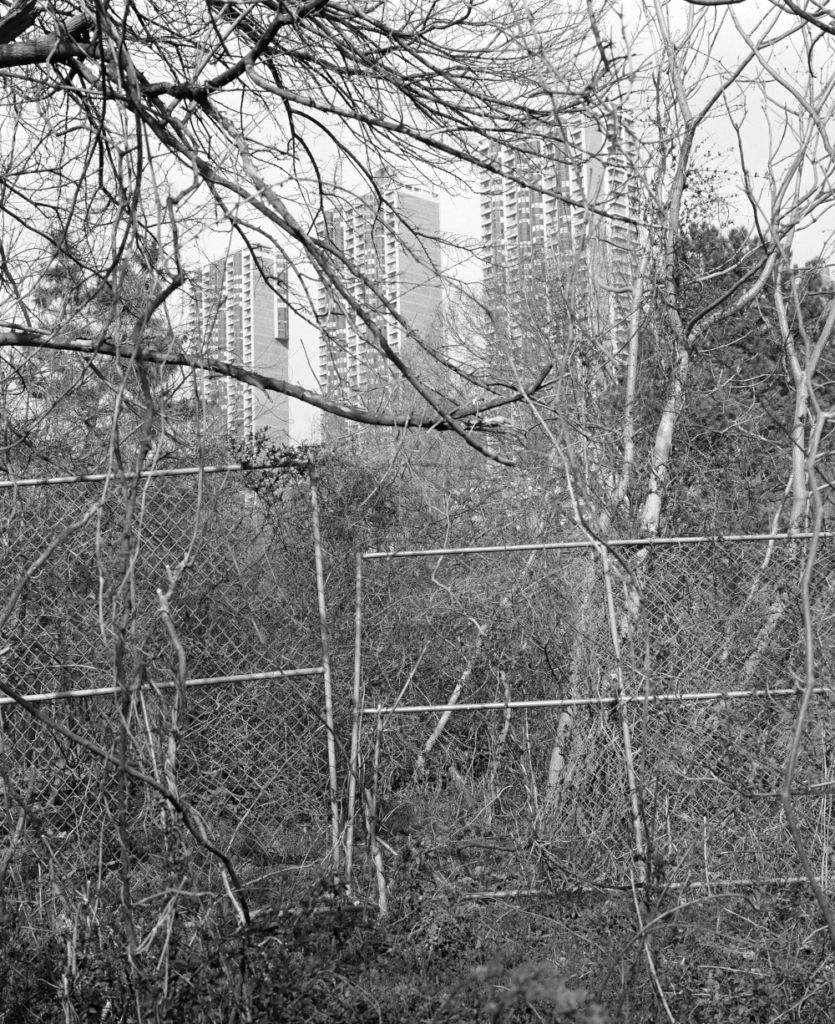
April 2018 / Hudson River Greenway, near George Washington Bridge © Antonio Rovaldi
As a scholar of restoration ecology, a discipline that seeks strategic remedies for damaged ecosystems, Handel sees Rovaldi’s project attending to issues of plant adaptation and human migration. The images are “not warm and fuzzy” but rather “messy, as an unplanned landscape is.” Rovaldi’s recordings of birdsongs mixed with traffic sounds made Handel think of Menno Schilthuizen’s writings on how some birds in Europe started to sing earlier or at a higher pitch, in response to the cacophony of rush hour. And Rovaldi’s photographs of plants growing out of cracks in the concrete spotlight the hardiness of weeds to survive even when the water supply turns saline, as it tends to do where the land meets the sea. These remind Handel of his research into plants introduced to the city’s wildlife from other places: they have a “personality fit to make it” akin to the survivalist profiles of human migrants. The adaptations of these rough plants—Handel calls them “urban ecotypes”—could be models for human resilience, for present or future climate refugees or for when the oceans rise to meet us. Wild vitality persists, managing even in the worst possible conditions.
Foreign Lands
What is it then between us?
What is the count of the scores or hundreds of years between us?— Walt Whitman, Crossing Brooklyn Ferry.
In this fervent couplet of questions, Whitman asks how he can relate to the land of New York City—the lines that follow this stanza mention both Brooklyn and Manhattan—given the differences in time scale that separate his own lifespan from the timeframe of the land. Similarly challenging distances affect, or infect, Rovaldi’s project. Separation is a characteristic condition of the mechanics of photography, because the camera stands between the photographer and the photographed, and this structural condition frames the image’s capacity to transport a viewer.
The analog process of photography, Rovaldi notes, creates gulfs of space as well as time: “the roll of film records a distance in the territory” between one frame and the next, because its photographs were taken as the artist was moving over land. Then, the process of printing from that film highlights the time lag between exposure and development: “When you’re working in the darkroom […] it’s an emotional moment, because you’re curious to see what’s going on with the picture that maybe you took two years before. You never know if it will be good or bad.” In the book The Sound of The Woodpecker Bill: New York City, Cecilia Canziani writes a particularly moving essay about the “reconstruction of a distance” in the photographic process. Revisiting the image after a hiatus, for Rovaldi, is like returning to a city or to a person from whom you have needed some space. The full relationship requires a distance as well as a return. Rovaldi calls all of these kinds of temporal and spatial distances “the grammar of photography.”
The issues involved in this grammar implicate the viewer as well as the photographer. How can we relate to the land in the image, despite the distances that separate us from it? How can our experience of the image take on a quality of immediacy? These questions become especially important if our involvement with the image is to spur any kind of climate action.
For the exhibition at Harvard, Rovaldi created engagement by arranging the space of the exhibition to refer to the geography of New York City. One wall of the library, containing Rovaldi’s photographs and a few of Benedetto’s maps, formed one “coast” of the exhibition space; another “shoreline” was the library’s wall of windows, in which more of Benedetto’s maps were mounted on translucent films. Also printed onto films were typeset transcriptions of Rovaldi’s work journals, chronicling the times and locations of his photographs. The interior space of the library then theatrically represented the island terrain that Rovaldi explored on foot. The visitor entering the exhibition was metaphorically reenacting the activity of traversing the terrain. Rovaldi made sure to include the touch of the real, in the form of the wall of horseshoe crab shells, and he offered an immersive audio recording of the landscape sounds—including the sound of the woodpecker bill—via headphones.
The experience of visiting one of Rovaldi’s exhibitions makes visitors relate to a New York landscape which remains far away. This remote quality echoes Rovaldi’s awareness of his own inevitable situation of “foreignness,” as he describes it. He is consistently trying to become acquainted with a land that is not only not his own hometown, but which also takes him away from his home culture. This undercurrent of distance fuels a spirit of humility and self-scrutiny: Rovaldi is constantly asking himself, “Where do I come from, where am I headed, and at what speed?” This set of questions recalls Gauguin’s famous and colossal painting, Where Do We Come From? What Are We? Where Are We Going? (1897-1898). While Rovaldi’s first two questions about location echo Gauguin’s categorical interrogations of human activity—necessary questions, especially in eras marked by colonialism—Rovaldi’s additional investigation into his own “speed” examines his own methodology. Does the metabolism of his working methods respond well to the demands of the land he is exploring? Is he slowing down and opening up enough to notice what is around him? (Are you?) Such questions model the thorough accountability necessary for planetary stewardship.
Alternative Endings
As I inhale the impalpable breezes that set in upon me,
As the ocean so mysterious rolls toward me closer and closer […]— Walt Whitman, As I Ebb’d with the Ocean of Life.
What can the ending be? For this article, for Rovaldi’s project, for our planet? Paul Strand and Charles Sheeler’s old art film ends in a sun-drenched, triumphalist, wide shot of New York City, but our climate forecasts no longer assure us of such sanguine futures. How might (Rovaldi’s) art offer visionary alternatives?
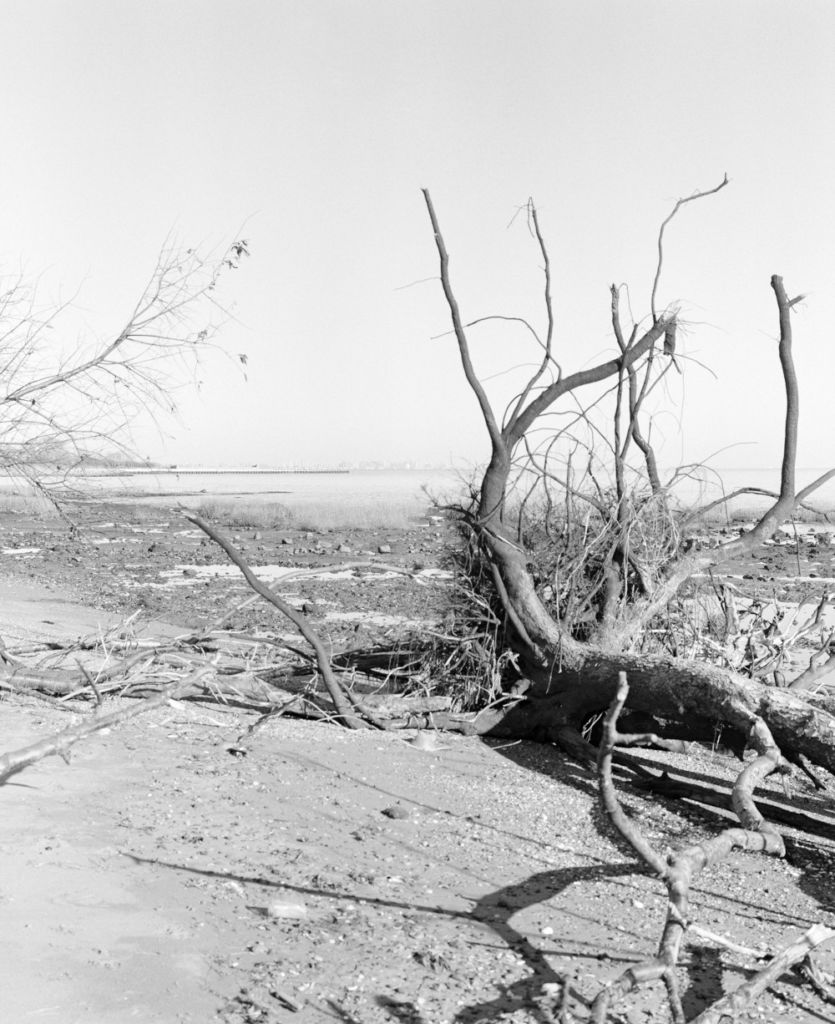
November 24, 2017 / Great Kills Park and Buffalo St © Antonio Rovaldi
Rovaldi points us toward provisional hope in ways that are, like everything else about his project, unexpected. The Sound of the Woodpecker Bill is, after all, “an impossible book,” declares Francesca Benedetto. It tries to encapsulate a city—a reality—that is too complex to be contained, even in a volume that is almost two inches thick. Rovaldi’s own summary insights emerge from his work with the camera. He presents the city from the perspective of its margins, and the images do not cohere into a clear narrative. Likewise, the narrative texts of the book are a symphony of voices he is conducting. They function like a novel, a genre that critic Mikhail Bakhtin describes as “heteroglossic” because of how it juxtaposes diverse discourses. And Rovaldi’s “romance” with the land does not have to be digested all at once; it can be picked up at different points at different times. The authors speak like a cast of characters, and it is possible to skip around in the book as one wanders through an exhibition space. This light touch is evident also in the video that Rovaldi made to accompany the exhibition at Harvard, showing him wandering among The Rest of the Images (2019, in collaboration with director Federica Ravera) in his studio in Milan: on occasion, old baseballs rolled casually across the screen, or brightly colored balls shared the studio floor with an array of books and photographic prints.
This nonlinear way of reading echoes the process of editing that Rovaldi went through to create both the book and its associated exhibitions. Engage, retreat; approach closer, create distance. Visit New York (and take photographs); go back to Milan (and piece together a new vision of the absent city). This inevitable grammar of photography means that he is able to forge another, imaginary version of the current world—and this visionary, constructive practice is perhaps a primary requirement for a response to climate change. Rovaldi is fond of quoting from a book by Amitav Ghosh, The Great Derangement: Climate Change and the Unthinkable, that “we need […] to envision what [another world] might be,” because “if there is any one thing that global warming has made perfectly clear it is that to think about the world only as it is amounts to a formula for collective suicide.”
Rovaldi’s concern for these issues made him see that access to the borderlands needed to be opened, to make possible a full response to the encroaching waters. “The waterfront is the only place where you can build something really new,” he observes, and here the idea of “building something” refers not to architectural construction but to visionary invention. So often, climate theorists apply their ideas to remote and rural landscapes, but New York’s borderland is just as untouched and uncharted, even though it is part of the world’s biggest city. It is indeed possible to address climate change through urban environments, but “if you deny access to the people, you’re done. The shore of Staten Island [for example] is really rough, and people don’t know what it is.” Getting to know the territory means that the land itself may indicate ways to address the threats to its existence. Just as the weeds thrive, and the blocked sightlines force new modes of photography, the realities of the land can—and perhaps inevitably will—motivate a new ecology.
A Rovaldian story should not end with any resolution, but rather with an openness to possibilities. And most fittingly, it should end in nature. Along New York’s raw coastlines, Rovaldi reports, a paradoxical condition prevails, one whose contradictions are ripe with potential. As he worked, he could sense the proximity of the city yet feel far from it. This distance was marked not by foreignness, but by reconnection to the timeless rhythms of the earth. In his essay for The Sound of The Woodpecker Bill: New York City, Rovaldi writes, “Most of the time I took my photographs in a state of almost unreal peace and silence, in those places where the density of the concrete suddenly gives way to a grassy area, where nature once again finds space in which to unfold […]” As Rovaldi’s work invites us to vicariously experience that border zone, we can begin to hear the silence as well as the sounds that emerge from it. Both can help to suggest ways forward in response to climate change, and in concert with the land itself.
What do you think endures?
Do you think a great city endures?— Walt Whitman, Song of the Broad-Axe.
Cover: Cedar Ave © Antonio Rovaldi, November 14, 2017
![November 14, 2017 / Cedar Ave]](https://www.switchonpaper.com/wp-content/uploads/2020/08/Cedar-Ave-rectang-e1597313025558-1024x751.jpg)








